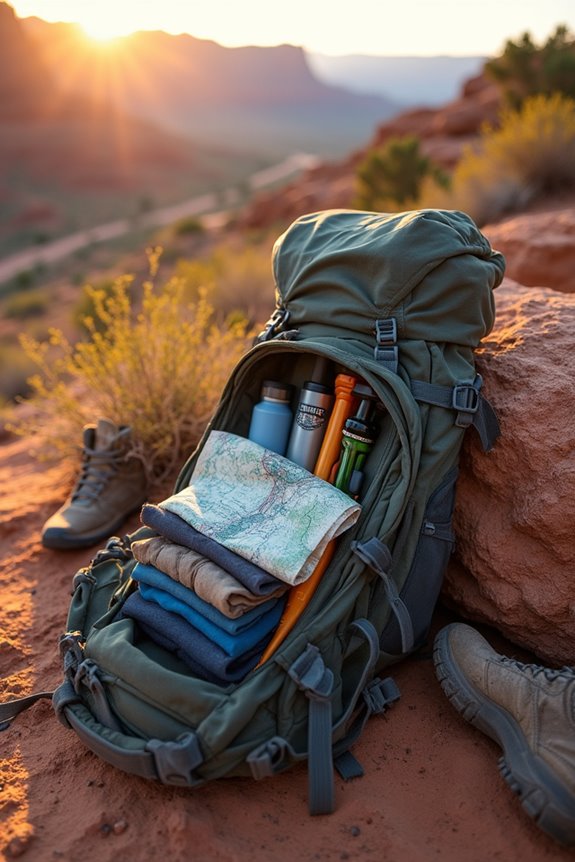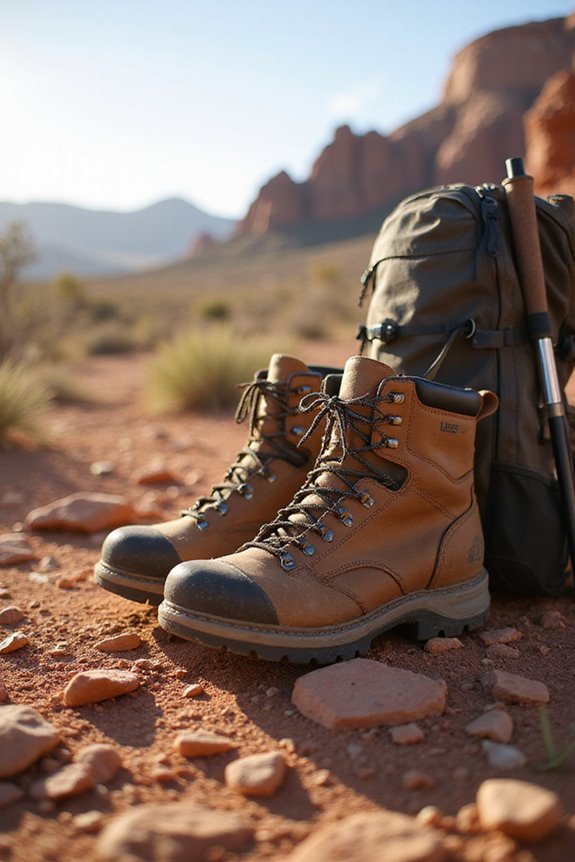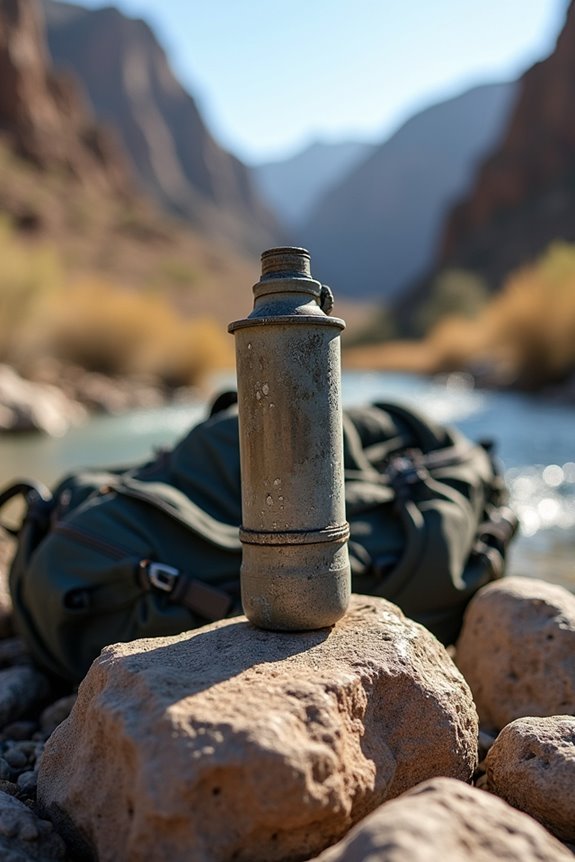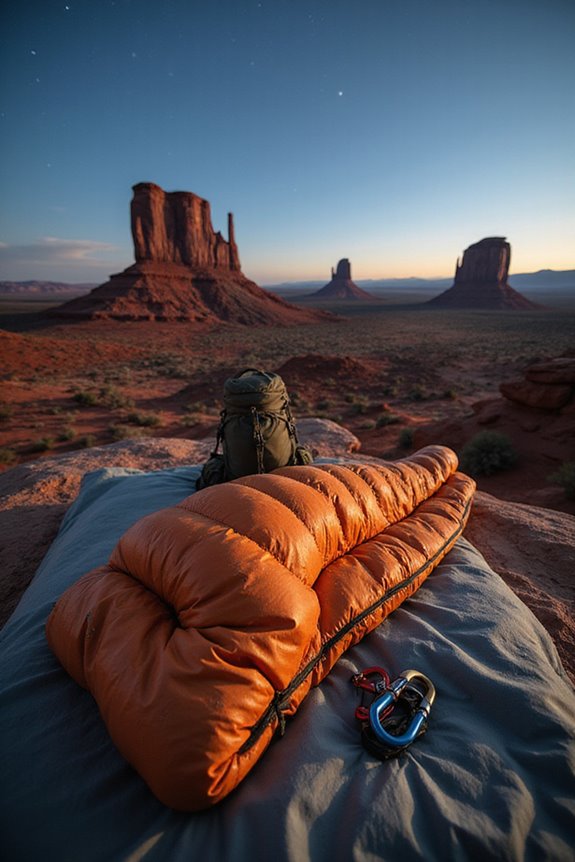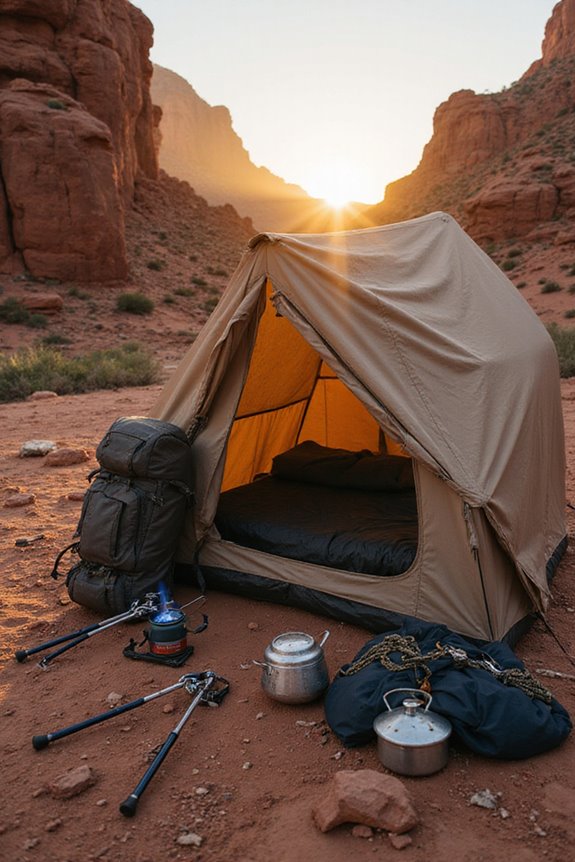When we hit the trails, packing the right hiking gear is a game changer! Let’s grab sturdy hiking boots for support and breathable clothes made from synthetic fabrics. Don’t forget a paper map and compass—those GPS devices sometimes fail us! We’ll need hydration reservoirs to stay energized and tasty, nutrient-dense snacks to keep our spirits high. Oh, and let’s throw in a first aid kit just in case! Stick around, and we’ll uncover more must-have items for our adventure!
Key Takeaways
- Choose appropriate footwear like hiking boots for support or lighter trail runners for well-maintained paths.
- Pack navigation tools, including a paper map, compass, and headlamp for safety during your hike.
- Carry a hydration system and a compact water filtration system for safe and convenient drinking water.
- Bring nutrient-dense snacks in airtight containers to maintain energy levels throughout your hike.
- Prepare for changing weather with insulating layers, waterproof jackets, and extra clothing.
Footwear and Clothing
When it comes to hitting the trails, we’ve got to kick things off with the right footwear and clothing, because nothing ruins a hike faster than sore feet or being drenched in sweat! Choosing the right footwear types is essential; hiking boots offer support and durability, while lighter trail runners are perfect for well-maintained paths. For winter hikes, boots with proper insulation ratings are crucial to maintain warmth and safety in extreme temperatures. Don’t forget about those clothing materials, either! Synthetic fabrics like polyester and merino wool work wonders for moisture management, keeping us comfortable. We should steer clear of cotton—it’s basically a sponge! So, as we lace up our boots or slide into those breathable hiking pants, let’s remember: the right gear gives us the freedom to explore without limits! Let the adventure begin!
Navigation and Safety Equipment
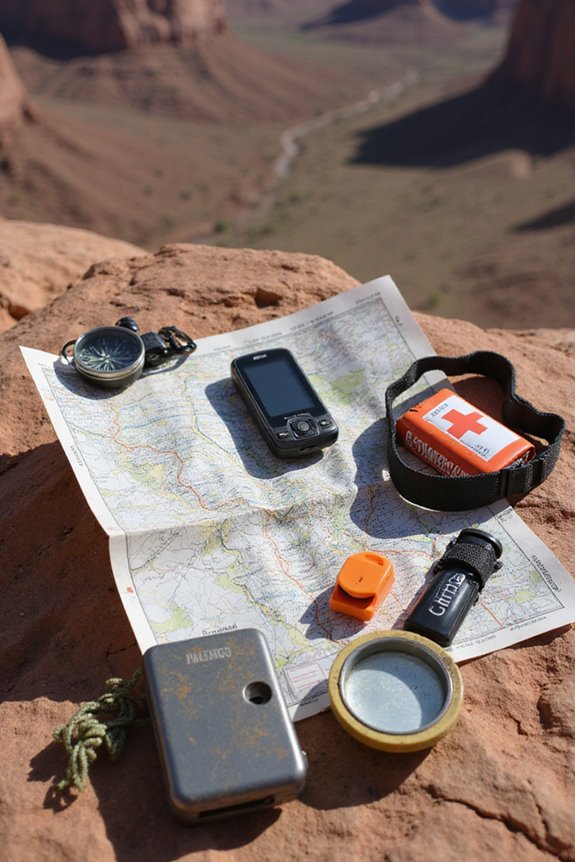
Finding our way through the great outdoors can feel like a thrilling treasure hunt, especially when we’ve got the right tools in our backpacks! We should never underestimate the power of a good paper map and compass—they’re our reliable friends when GPS fails. Utilizing these navigation techniques keeps us oriented even in the wildest places.
And let’s not forget our safety protocols! A survival whistle can really shout our need for help, while a headlamp lights our way if adventure stretches into the night. We’ve got our thorough first aid kit at the ready, too, just in case our outer explorer gets rough. Let’s embrace the freedom of nature, while ensuring we’re safe and sound on our quests! An emergency hand crank radio with solar power can be invaluable during unexpected weather changes or when communication becomes necessary in remote areas.
Water and Hydration
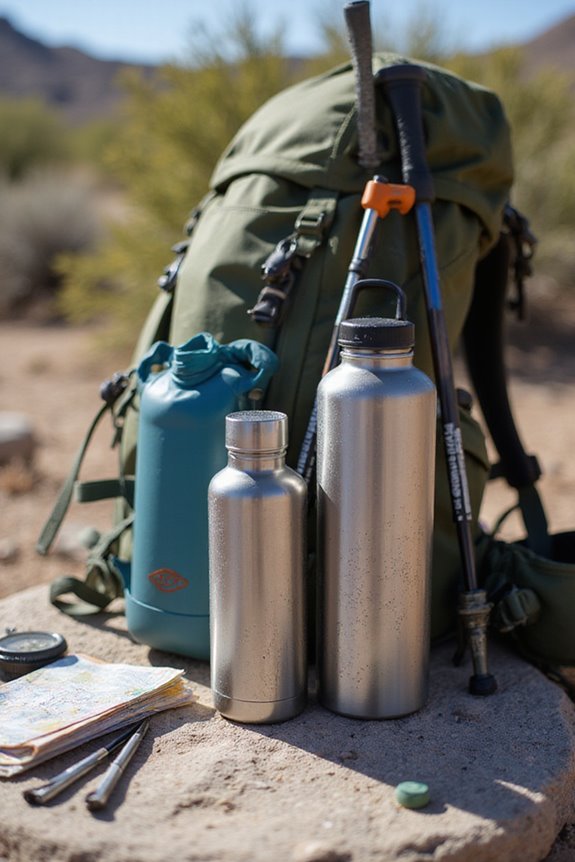
Staying properly hydrated is essential for our hiking adventures, just like packing enough snacks to fend off hunger! We love using hydration reservoirs—they let us sip on-the-go with a bite valve and tube, keeping us refreshed without losing momentum. For those longer hikes, having a compact water filtration system is a game-changer; we can refill from natural water sources safely. Quality filters remove harmful bacteria and viruses while being lightweight enough to carry comfortably on any trail.
Food and Nutrition
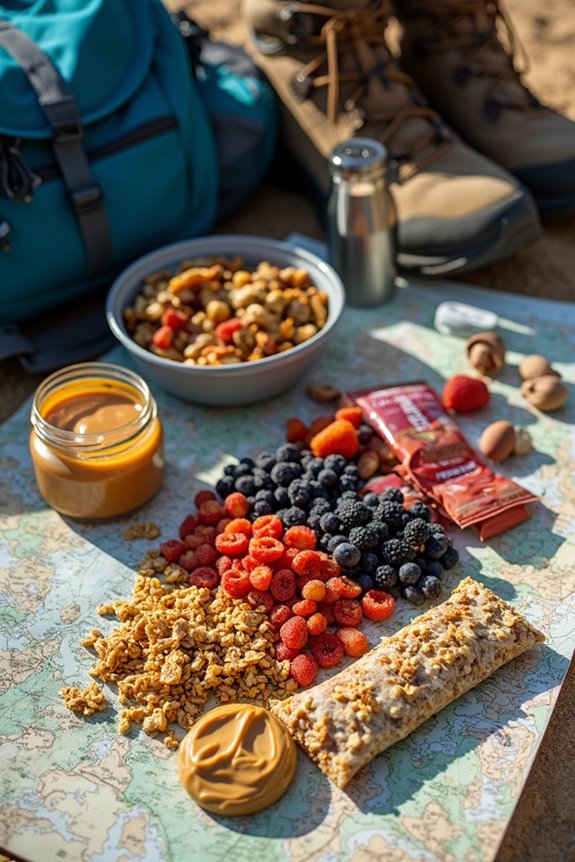
As we gear up for our next hiking adventure, one thing we absolutely can’t overlook is our food and nutrition. The right fuel can make or break our experience! We need nutrient-dense snacks to keep our energy high without weighing us down. Think trail mix packed with nuts, seeds, and dried fruits—they’re like little powerhouse snacks!
For calorie counting, let’s aim for a balance: 45-55% carbs for energy, 35-40% fats for lasting fuel, and a dash of protein for recovery. We should munch on small portions often; it’s much easier than waiting for a big meal! Remember, nothing says adventure quite like fresh fruit straight from our pack. Using airtight containers for food storage will protect your snacks from moisture and wildlife while keeping everything fresh throughout your hike. So, let’s pack wisely and let our taste buds roam free on the trail!
Backpack and Carrying Gear
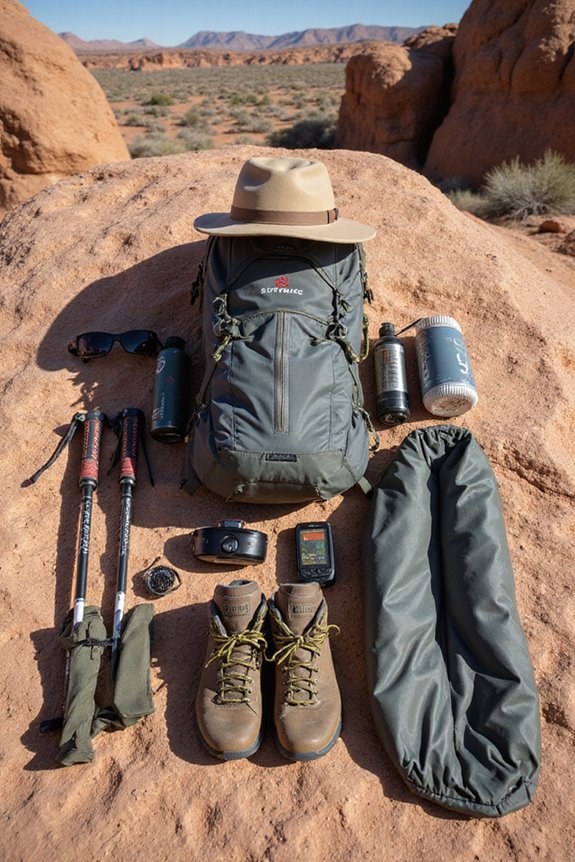
Choosing the right backpack is like selecting the perfect dance partner; it can make your hiking experience a joyous celebration or a cumbersome struggle! We want a backpack that fits our body well, and offers ventilation and comfort—think padded straps and adjustable hip belts. Internal or external frames? It’s all about what our adventure needs!
For day hikes, a 20-35 liter pack works wonders, while overnight trips crave 40-70 liters. Don’t forget carrying options like trekking poles—they’re a game changer on rocky terrain! Oh, and hydration? Opt for packs that let us sip hands-free. Look for backpacks with AirScape suspension systems that provide excellent breathability and prevent excessive back sweat during strenuous hikes. With versatile compartments and external attachment points, we can carry everything—minus the kitchen sink—while still groovin’ on the trail. Let’s embrace the freedom of the great outdoors!
Emergency and Weather Preparedness
When we venture into the wild, we never know what Mother Nature has in store for us! That’s why packing essential first aid supplies is vital. A compact first aid kit should include bandages, antiseptic wipes, and pain relievers. Don’t forget tweezers for pesky splinters! Now, let’s talk weather gear. We need to be ready for anything—think insulating layers, waterproof jackets, and extra clothing just in case the forecast decides to throw a curveball. A rain shell is our best friend when the skies open up! And let’s be real: nothing beats that feeling of warmth and comfort when we’re protected from the elements. Stay prepared, and we’ll enjoy our freedom in the great outdoors!
Additional Gear and Accessories
After we’ve tackled the importance of being prepared for weather surprises and emergencies, let’s gear up for the fun stuff! Packing additional gear and accessories can take our hiking experience to the next level. First, don’t forget navigation tools—whether a trusty map or a GPS device, getting lost isn’t part of the adventure!
And while we’re at it, let’s optimise our backpacks with lightweight camping gear that fits snugly. Good hiking boots are a must, and let’s not underestimate the power of moisture-wicking socks. Solar protection is key; bring along UV sunglasses, a wide-brimmed hat, and don’t skimp on sunscreen. Remember, freedom on the trail also means being prepared—let’s make every hike enjoyable and safe!
Frequently Asked Questions
How Do I Choose the Right Hiking Trail for My Skill Level?
Did you know that 70% of hikers underestimate trail difficulty? We must evaluate terrain features and personal skill levels, choosing trails that match our abilities to guarantee a rewarding adventure without unnecessary challenges. Enjoy your freedom!
What Are the Best Practices for Wildlife Encounters During Hikes?
When it comes to wildlife encounters, we’ve got to prioritize bear safety and understand wildlife behavior. By staying alert and respecting their space, we can enjoy our hikes and guarantee a harmonious coexistence with nature.
How Can I Minimize Weight in My Hiking Pack?
To minimize weight in our hiking pack, let’s organize gear by purpose. For instance, we can choose ultralight materials for our tent and pack clothing effectively, ensuring freedom to roam without unnecessary bulk or burden.
Are There Specific Guidelines for Hiking Alone Safely?
When it comes to solo hiking, we should prioritize safety tips like informing someone of our plans, staying aware of our surroundings, and knowing our limits. Embracing freedom means preparing wisely for our adventures!
How Can I Effectively Train for Longer Hikes in Advance?
How do we prepare for those longer hikes we crave? By embracing endurance training and strength building, we can gradually increase our stamina and power, allowing us to explore nature’s wonders with confidence and freedom.

